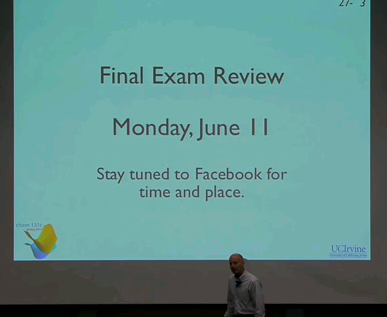UCI Chem 131C Thermodynamics and Chemical Dynamics (Spring 2012)
Lec 27. Thermodynamics and Chemical Dynamics -- The Final Exam --
View the complete course: ../courses/chem_131c_thermodynamics_and_chemical_dynamics.html
Instructor: Reginald Penner, Ph.D.
License: Creative Commons BY-NC-SA
Terms of Use: ../info.
More courses at http://ocw.uci.edu
Description: In Chemistry 131C, students will study how to calculate macroscopic chemical properties of systems. This course will build on the microscopic understanding (Chemical Physics) to reinforce and expand your understanding of the basic thermo-chemistry concepts from General Chemistry (Physical Chemistry.) We then go on to study how chemical reaction rates are measured and calculated from molecular properties. Topics covered include: Energy, entropy, and the thermodynamic potentials; Chemical equilibrium; and Chemical kinetics. This video is part of a 27-lecture undergraduate-level course titled "Thermodynamics and Chemical Dynamics" taught at UC Irvine by Professor Reginald M. Penner.
Thermodynamics and Chemical Dynamics (Chem 131C) is part of OpenChem: ../openchem/
Recorded on June 12, 2012.
Index of Topics:
00:22 - The Final Exam
05:36 - TST For Ionic Reactions in Solution
07:26 - How does the Ionic Content of a Solution Influence the Reaction Rate when Reactants are Charged?
08:52 - How Equilibrium is Influenced by Ions in Solution and the Debye-Huckel Limiting law
11:06 - Graphing what the Debye-Huckel Limiting Law Predicts
13:00 - What We Want to Know About the Plot of the Graph
14:40 - How the Equilibrium Constant is Affected by the Ionic Strength
15:33 - The Thermodynamic Equilibrium Constant and the Concentration Equilibrium Constant
16:40 - Comparing The Thermodynamic Equilibrium Constant and the Concentration Equilibrium Constant
18:28 - Question: Adding NaCl to a Solution of Acetic Acid
21:46 - Question: Solubility of the Above Problem
24:58 - Why Does This Happen? Oppositely Charge Ions Attract...
25:37 - Freely Arranging Ions In Order to Lower Their Energy
27:58 - Favoring the Most Ionic State of the System
28:23 - Applying this Logic to the TST Treatment of the Reaction
29:52 - Equations at Infinite Dilution
30:36 - Master Equation for Transition State Theory and What it Predicts
31:02 - Plotting What is Predicted
34:05 - The 131C Final Exam
35:57 - Review Problem: Calculating The Michaelis Constant, Km, Vmax, Turnover Number, Catalytic Efficiency of an Enzyme
36:33 - In Enzyme Kinetics, This is the Mechanism that Operates
37:32 - Michaeilis-Menten Kinetics Graph: Reaction Rate/Substrate Concentration
38:24 - The Lineweaver-Burk Plot
39:19 - What Your Plot Should Look Like Qualitatively
40:11 - Example Problem: Chemical Kinetics: Steady State Reaction
46:18 - More Kinetic Issues- Rules for Reaction Rate
47:06 - Method 1 for Experimentally Determining the Rate Law
48:25 - Method 2 for Experimentally Determining the Rate Law
48:41 - Example of Method 2
49:00 - Method 3: Measuring the Influence of the Initial Reactant Concentration of the Reaction Half-Life
49:36 - Summary of Three Methods
49:39 - The Arrhenius Equation
Required attribution: Penner, Reginald Thermodynamics and Chemical Dynamics 131C (UCI OpenCourseWare: University of California, Irvine), ../courses/chem_131c_thermodynamics_and_chemical_dynamics.html. [Access date]. License: Creative Commons Attribution-ShareAlike 3.0 United States License.


